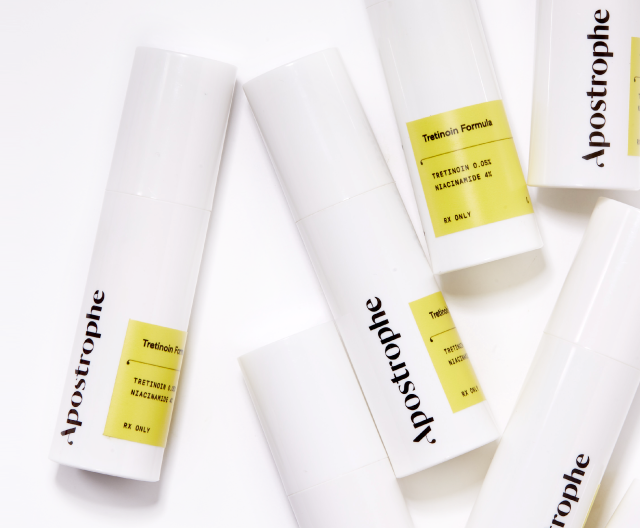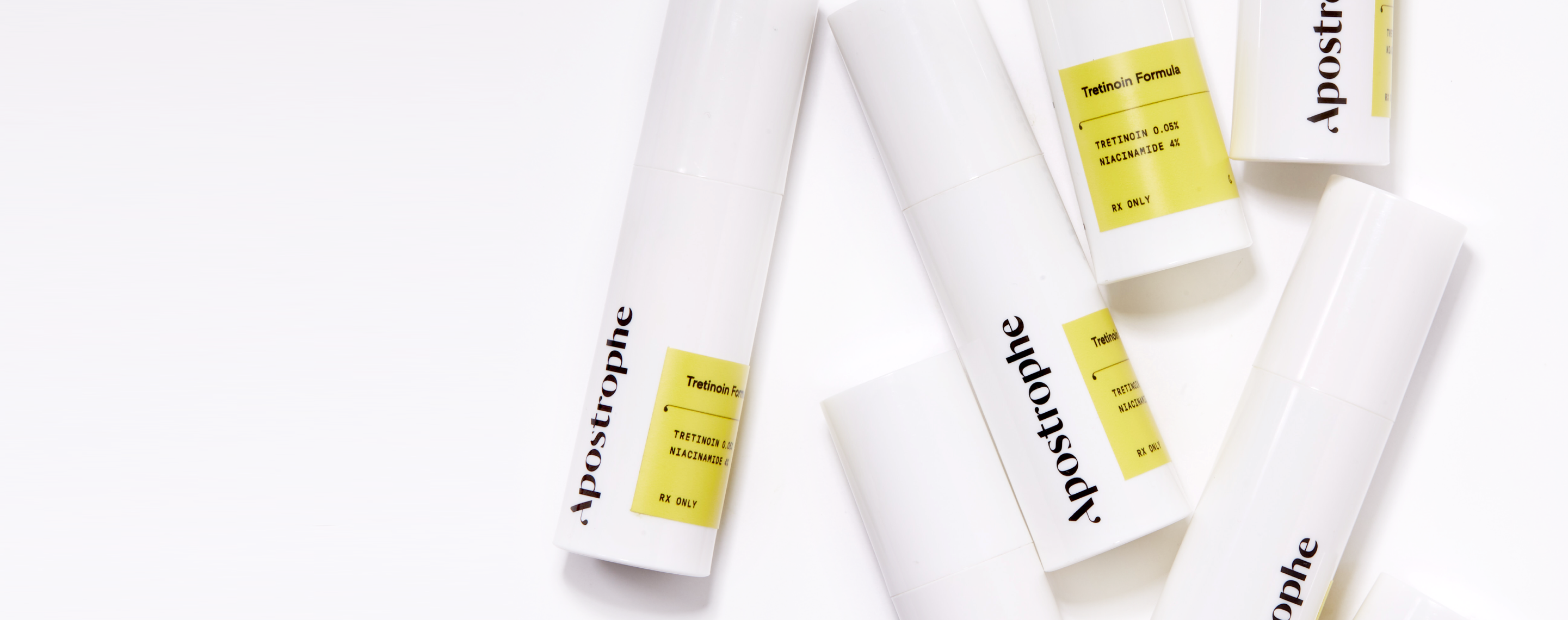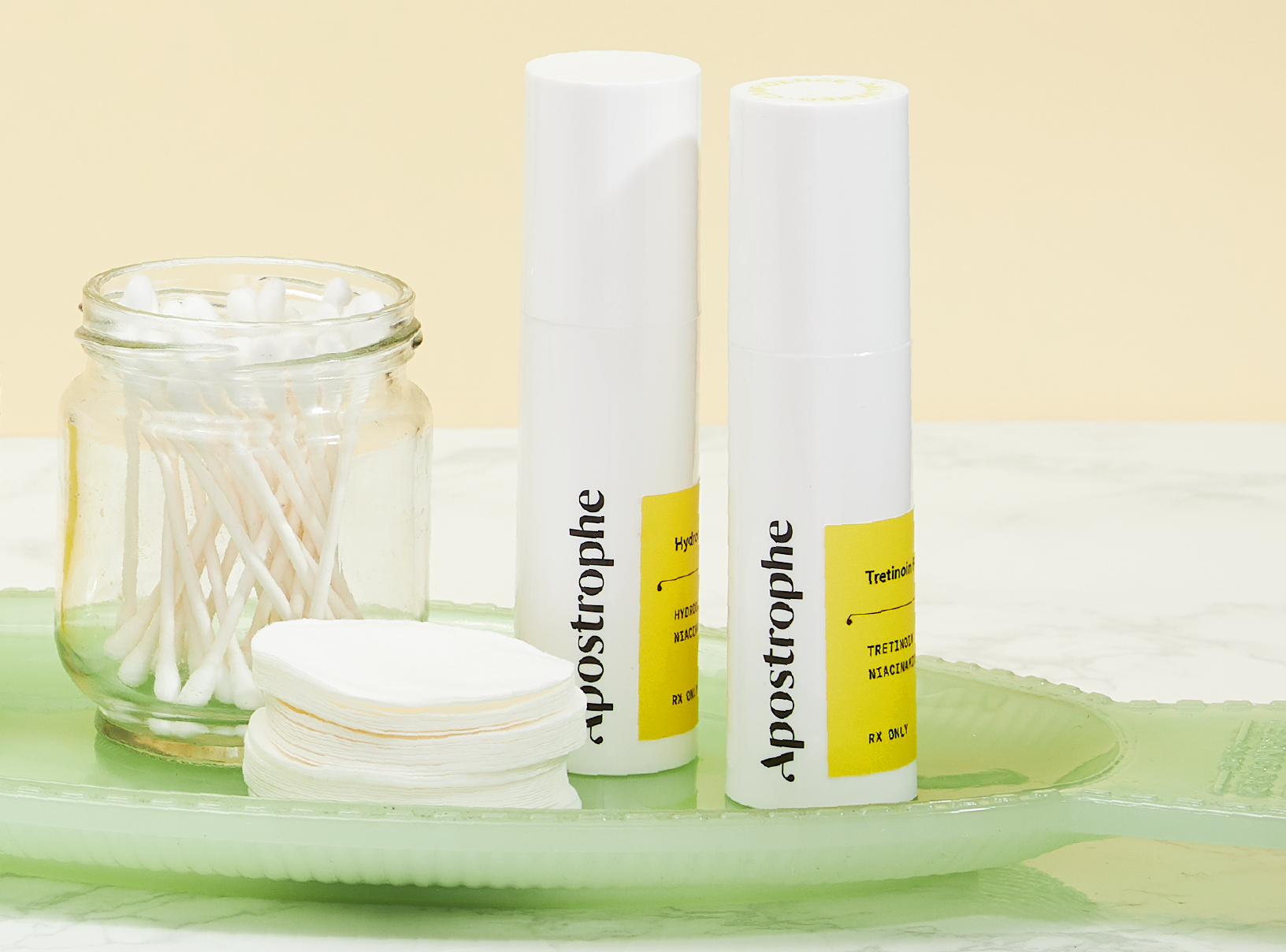Education
Skin Lightening with Tretinoin (Retin-A): The Facts


SHARE
Education
Skin Lightening with Tretinoin (Retin-A): The Facts
Medically reviewed by Kristin Hall, FNP
Written by Apostrophe Team
Last updated 4/1/2024
Widely used to treat acne and anti-aging, tretinoin can also help to reduce the appearance of skin discoloration and hyperpigmentation — common conditions in which some patches of skin become darker than the rest of the skin, typically on the face, neck, hands, shoulders, and other areas of the body that typically get a lot of sunlight.
Because of this, tretinoin is often confused with skin whitening products and skin “bleaching” chemicals, despite not fitting into either category. In this guide, we’ll explain what tretinoin can do for your skin tone, as well as what it won’t do as a topical skincare treatment.
Tretinoin Can Slightly Lighten Your Skin
Most commonly, tretinoin is used to treat acne and reduce the visibility of wrinkles and other signs of aging.
From a pharmaceutical perspective, it’s a topical retinoid — a medicine that works by increasing the speed at which your body produces new skin cells.
This can reduce the effects of photoaging, or the process by which your skin ages and lines, wrinkles, and age spots develop.
Dermatologists sometimes prescribe tretinoin to treat hyperpigmentation, which is caused when certain areas of skin have an excess of melanin, the natural pigment responsible for a darker skin tone.
Studies show that tretinoin cream reduces the melanin content of the skin when used for a long period of time, helping to even out areas affected by hyperpigmentation.

HYPERPIGMENTATION TREATMENT
Target dark spots and hyperpigmentation with customized prescription treatment.
For example, one 2004 study observed 54 black patients in a randomized, double-blind, vehicle-controlled clinical setting for 40 weeks and found that in the treatment of post-inflammatory hyperpigmentation (a specific type of hyperpigmentation), 0.1 percent tretinoin was effective in lightening the effects of hyperpigmentation.
Other studies have resulted in similar findings, with topical tretinoin usage correlating with a decline in dermal melanin levels.
Essentially, the research shows that tretinoin may slightly lighten your skin tone over the course of several weeks or months of treatment.
Tretinoin can also affect your skin’s sensitivity to the sun — a topic we’ve covered in our guide to protecting your skin from sunburn while using tretinoin.
On the whole, tretinoin might slightly lighten your skin tone over the long term. However, it only affects the areas to which it’s applied and doesn’t affect melanin synthesis, meaning there’s no need to worry about your overall skin tone changing as a result of mild tretinoin usage.
Tretinoin Does Not “Bleach” Your Skin
Contrary to popular belief, tretinoin is not a “bleaching agent” or medicine designed specifically to lighten your skin tone.
While tretinoin can even out patches of hyperpigmentation and cause a mild change in your skin tone, it doesn’t affect melanin synthesis.
This means that your body will still produce melanin as usual, even while you use topical tretinoin to treat acne or the signs of aging.
Skin lightening agents such as hydroquinone, which is available as a prescription medicine, work via a completely different process from tretinoin.
While topical tretinoin speeds up cell turnover and can cause a slight skin lightening effect in the process, skin lightening agents work by actively preventing your body from producing a normal amount of melanin.
For example, topical hydroquinone works by inhibiting skin from producing melanin. The areas of skin to which hydroquinone is applied no longer produce a normal amount of pigmentation, resulting in a significant lightening effect.
In short, while tretinoin might slightly lighten your skin tone with long-term use over weeks or months, it’s not a skin “bleaching” agent or lightening product. Any lightening effects from tretinoin are secondary to its primary effects as an anti-aging and acne treatment.
In fact, it’s worth noting that tretinoin and skin lightening agents like hydroquinone are often used in combination with one another to achieve optimal results.
Learn More About Tretinoin
Are you interested in using tretinoin to treat acne or prevent the effects of aging? Our guides to using tretinoin as an acne treatment and for anti-aging effects cover the two most common uses of tretinoin, with simple tips and how-to instructions to help you get the best results.

PRESCRIPTION TRETINOIN
Target acne, dark spots, and signs of aging with this science-backed ingredient.
You can also learn more about tretinoin as a medication in our Tretinoin 101 guide, which goes into more detail on how tretinoin works, its potential side effects, and the most common brands of tretinoin sold in the United States and internationally.
Shop this post

Tretinoin
Like what you just read? Sign up for our email list to get the scoop on skincare science delivered straight to your inbox.

Deep Dives
A dermatologist shares his thoughts on the recent studies about benzoyl peroxide and benzene.
Read More
Education
What is milia?
What is milia? Today, we’re jumping into one type of bump that you may have heard about most commonly in infants — milia.
Read More
Education
Best moisturizer for acne-prone skin
If you have combination acne-prone skin, figuring out which moisturizer is best for your skin might be tough. In this guide, we break down the best moisturizer for combination, acne-prone skin.
Read More